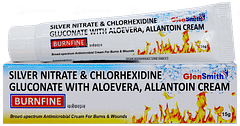Chlorhexidine + Lidocaine / Lignocaine + Silver Sulfadiazine
Uses of Chlorhexidine + Lidocaine / Lignocaine + Silver Sulfadiazine
Chlorhexidine + Lidocaine / Lignocaine + Silver Sulfadiazine is primarily used for managing burned skin surfaces and belongs to the group of antiseptic, anaesthetic, and antibacterial medicines.
Additionally, it is indicated for preventing bacterial infections in second and third-degree burns, relieving pain and discomfort associated with burns and wounds, and promoting healing in damaged skin.
Side effects of Chlorhexidine + Lidocaine / Lignocaine + Silver Sulfadiazine
Burning or stinging at the application site
Itching or rash
Skin discolouration
Allergic reactions
How Chlorhexidine + Lidocaine / Lignocaine + Silver Sulfadiazine works
- Chlorhexidine + Lidocaine / Lignocaine + Silver Sulfadiazine is a combination used for managing burns and wounds.
- Chlorhexidine disrupts the cell membranes of bacteria, causing their components to leak out, effectively killing them. This provides antiseptic action by eliminating a wide range of bacteria, viruses, and fungi.
- Lidocaine / Lignocaine is a local anaesthetic. It blocks sodium channels in nerve cells, halting the transmission of nerve signals. This results in numbness and relief from pain in the applied area.
- Silver Sulfadiazine slows down the growth of bacteria by interfering with their DNA synthesis. The silver element also contributes to its antimicrobial effects. This combined action helps in preventing and managing bacterial infections in burns and wounds.
Certified content
Written By

BDS, MDS
Reviewed By

BMS, FMC, MD Resident
Expert Advice
Dosage Forms Available
Chlorhexidine + Lidocaine / Lignocaine + Silver Sulfadiazine is applied topically (cream).
It is applied directly to the skin on the affected area.
Age and Dose Restrictions
This medicine is meant for use in adults and children over the age of 2 months.
Contraindications
This medicine is contraindicated in patients with known hypersensitivity to chlorhexidine, lidocaine, silver sulfadiazine, sulfa medications, or any component of the formulation. It is also contraindicated in premature infants or infants less than 2 months old.
Other Medications to Avoid
This combination may interact with other topical medications (such as hydrocortisone cream), systemic antibiotics like sulfonamides (including trimethoprim), and neuromuscular blocking agents (such as vecuronium).
Overdose and Missed Dose
An overdose of this medication may cause excessive skin irritation and an increased risk of systemic toxicity from silver or lidocaine absorption. If you observe these symptoms, wash the area with water and consult your doctor immediately.
If you forget to apply this cream at the scheduled time, apply it as soon as you remember. However, if it is nearly time for your next application, skip the missed application and continue with your regular schedule. Do not apply extra cream to make up for a missed dose.
Management of Side Effects
Most side effects are temporary and generally harmless and resolve when discontinuing this medicine. However, if you experience any severe side effects or worsening symptoms, please consult your doctor.
Apply a cold compress to relieve minor burning or stinging sensations temporarily.
Wash the area gently with water if itching persists.
Use in Driving and Operating Machinery
This medicine does not affect your ability to drive or operate machinery. However, be cautious of applying near areas that might contact clothing that could then contact eyes or other sensitive areas.
Use in Pregnancy and Lactation
Consultation with a doctor is advised before using this medicine during pregnancy or while breastfeeding. It should only be used when clearly needed and under the supervision of a doctor.
Caution in Other Conditions
Caution should be exercised when using this medicine in patients with severe hepatic or renal impairment due to potential systemic absorption, especially when large body surface areas are treated.
Special Dietary and Lifestyle Recommendations
Maintain good hygiene and cleanliness of the affected area to support optimal healing.
Wear loose, breathable clothing over the treated area to prevent irritation.
Ensure adequate hydration to support overall skin health.
Avoid direct sunlight on treated areas to reduce the risk of photosensitivity reactions from chlorhexidine.
Frequently asked questions
Can Chlorhexidine + Lidocaine / Lignocaine + Silver Sulfadiazine be used on all types of burns?
Chlorhexidine + Lidocaine / Lignocaine + Silver Sulfadiazine is primarily used for second and third-degree burns. The cream helps to cleanse and debride the burnt skin surfaces, prevent bacterial infections, and relieve pain and discomfort.
Can Chlorhexidine + Lidocaine / Lignocaine + Silver Sulfadiazine be applied to wounds other than burns?
While this combination cream is mainly indicated for burns, it may also be applied to other types of wounds under the direction of a doctor. However, it should not be used on deep, punctured, or surgical wounds without medical supervision.
Does Chlorhexidine + Lidocaine / Lignocaine + Silver Sulfadiazine have an immediate effect after application?
The anaesthetic effect of lidocaine occurs within a few minutes of application. The antiseptic and antibiotic actions of chlorhexidine and silver sulfadiazine provide ongoing protection against infections.
What is the best time to use Chlorhexidine + Lidocaine/Lignocaine + Silver Sulfadiazine?
Apply this combination as directed by your doctor, usually after cleaning the wound. It is often used depending on the severity of the wound and the treatment plan.
Does Chlorhexidine + Lidocaine / Lignocaine + Silver Sulfadiazine cause any allergies?
Some individuals may have hypersensitivity to components in the formulation, which can lead to allergic reactions. If you notice signs of a serious allergic reaction like facial swelling, difficulty breathing, or hives, seek immediate medical attention.
How long does it take for Chlorhexidine + Lidocaine/Lignocaine + Silver Sulfadiazine to show effects?
You may notice improvement in pain relief and wound condition within a few days of starting treatment. The exact time can vary depending on the wound type and severity.
Does Chlorhexidine + Lidocaine/Lignocaine + Silver Sulfadiazine impact mood?
This topical treatment should not significantly impact mood. However, if you experience discomfort or irritation, it could potentially affect your overall well-being.
Chlorhexidine + Lidocaine / Lignocaine + Silver Sulfadiazine in other salts
List of Medicines for Chlorhexidine + Lidocaine / Lignocaine + Silver Sulfadiazine

Company
About UsHealth ArticleHealth StoriesDiseases & Health ConditionsAll MedicinesAll BrandsNeed HelpFAQSubscribe
Registered Office Address
Grievance Officer
Download Truemeds

Contact Us
Our customer representative team is available 7 days a week from 9 am - 9 pm.
v3.7.11
Our Payment Partners








